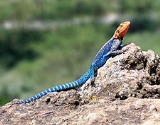
Agama agama
Encyclopedia

Lizard
Lizards are a widespread group of squamate reptiles, with nearly 3800 species, ranging across all continents except Antarctica as well as most oceanic island chains...
from the Agamidae
Agamidae
Agamids, lizards of the family Agamidae, include more than 300 species in Africa, Asia, Australia, and a few in Southern Europe. Many species are commonly called dragons or dragon lizards. Phylogenetically they may be sister to the Iguanidae, and have a similar appearance. Agamids usually have...
family
Family (biology)
In biological classification, family is* a taxonomic rank. Other well-known ranks are life, domain, kingdom, phylum, class, order, genus, and species, with family fitting between order and genus. As for the other well-known ranks, there is the option of an immediately lower rank, indicated by the...
, found in most of Subsaharan Africa.
It can often be seen in the heat of the day. In the breeding season, the males develop their most dramatic markings, the head and neck and also tail turning bright orange, and the body dark blue. Outside of the breeding season, the male is a plain brown. The females and juveniles are always more cryptically marked. This lizard can be climbing rocks and walls. The diet is insects.
The males are territorial claiming relatively small to medium patches of land that they defend against other mature males. Juveniles and females reside within the territories unchallenged. The mature males become agitated when confronting each other; nods vigorously, arching, skipping sideways, and clashing tails. The loser is chased out of the territory.

